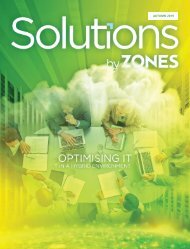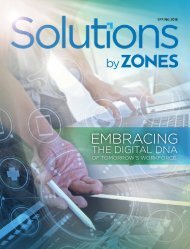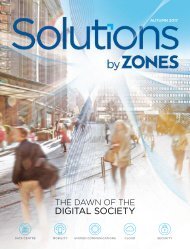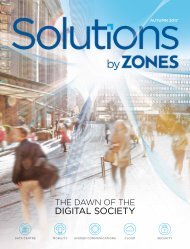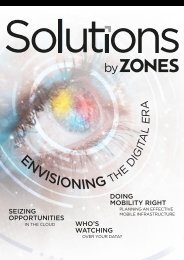Solutions Guide Autumn 18
Create successful ePaper yourself
Turn your PDF publications into a flip-book with our unique Google optimized e-Paper software.
FREE UP<br />
YOUR IT STAFF.<br />
64 %<br />
less staff time to complete<br />
business extensions.<br />
less staff time<br />
to deploy storage.<br />
less staff time to run VxRail,<br />
VxRack environments.<br />
FASTER SERVER<br />
(APPLIANCE NODE)<br />
DEPLOYMENTS<br />
83%<br />
81%<br />
56%<br />
Real-world<br />
advantages.<br />
By the very nature of the way<br />
hyperconverged works, virtual<br />
desktop infrastructure (VDI) is a<br />
typical use case for the technology.<br />
“It is great for VDI as you can scale out<br />
the solution as you scale users and get<br />
predictable performance for the end<br />
user as you scale,” Doverspike said.<br />
“And of course, the built-in replication<br />
capabilities mean you can support<br />
high availability and low latency in<br />
geographically disparate sites.”<br />
One national airline recently turned<br />
to Zones for a hyperconverged<br />
implementation after years of<br />
outsourcing its infrastructure to<br />
colocation facilities. “They had some<br />
outages that severely impacted them,”<br />
Barnhart explained. “So, they decided<br />
to take matters into their own hands.”<br />
Now, the airline is running some<br />
of their workloads in their new<br />
hyperconverged environment, but<br />
they’re looking to bring all of that<br />
infrastructure in house – with a good<br />
majority of that running on HCI –<br />
including their critical tier-one apps<br />
and their ecommerce platform as well.<br />
“Hyperconverged infrastructure also<br />
presents a natural evolution to a<br />
software-defined data centre and the<br />
cloud,” said Doverspike. “In addition to<br />
being able to manage their nodes or<br />
clusters through intuitive, easy-to-use<br />
software from a centralized location,<br />
our key hyperconverged partners offer<br />
RESTful APIs and direct integration<br />
with the major cloud players. As a<br />
result, hyperconverged infrastructure<br />
plays a critical role in our customers’<br />
hybrid IT environments.”<br />
Hyperconverged infrastructure<br />
also allows clients with traditional<br />
three-tier architecture to take a<br />
phased approach to upgrading the<br />
data centre. “In some cases, clients<br />
might rely on legacy systems to run<br />
mission-critical apps but may be<br />
concerned about migrating them to<br />
a new technology since they know<br />
their existing environment more or<br />
less works,” Barnhart added. “We<br />
see such customers initially use<br />
hyperconverged with a tier-two<br />
app and then scale out over time<br />
as they realize the benefits that<br />
hyperconverged provides. I can’t<br />
recall an example where a customer<br />
migrated a workload from their legacy<br />
environment to a hyperconverged<br />
environment and – after running<br />
it in their new hyperconverged<br />
environment – moved it back to their<br />
three-tier architecture for any reason.”<br />
“We have clients who may decide to<br />
keep their legacy architecture in place<br />
for older apps and then build out a<br />
whole new paradigm around software<br />
defined, slowly growing their app<br />
collection,” Doverspike commented.<br />
“Eventually, they’ll start moving over<br />
tier-one business apps a little at a time<br />
– never taking a big risk – until such<br />
time as they can totally decommission<br />
the old systems.” It’s a process of<br />
building up a repertoire of scale-out<br />
architecture and scale-out apps.<br />
uk.zones.com +44 20 7608 7676 23








